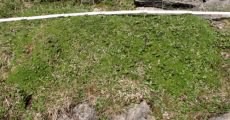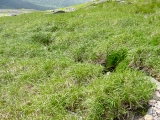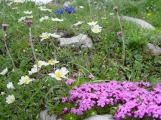 |
|
|
|
|
|
|
Given the difficult growing conditions in alpine environments, we would expect to find special life history characteristics that help plants survive in these habitats and also spread to new locations. So, what are the ecological characteristics of plants from high elevations? |
|
Many alpine plant species have long life spans. They conserve resources to reduce the risk of mortality. In the long run, this may compensate for a decrease in growth rate as the environmental harshness increases. Typical examples are cushion plants like Silene acaulis that grow slowly but steadily, with the cushion enlarging by only a few mm each year. Cushions that measure half a metre in diameter or more could easily be a century old. |
1 - Silene acaulis cushion of about 1 m length (131K) |
|
In regions with a cold climate and short growing season ephemeral plants must be able to complete their life cycle within a few weeks. Not surprisingly, plants with an annual life cycle are very rare in the alpine environment, though a few do exist. As environmental harshness increases, a general increase in the proportion of perennating tissue can be observed in the alpine flora. This both parallels and forms the basis for the long life spans in many alpine plants. A large amount of storage tissue facilitates rapid sprouting in spring and may protect the plants from increased mortality in poor growing seasons when the plant's energy balance is close to zero and may even be negative. Another kind of slow turnover, the maintenance of standing dead tissue around the plant's living parts, also appears to help plants survive in harsh environments. It is thought that these dead tissues protect plants from environmental hazards such as frost, and may also help in the reutilization of nutrients. |
| Click on the different stages of the life cycle below to learn about some common life history characteristics of alpine plants. |
|
In communities dominated by long-lived and slow-growing plants, species composition is quite stable and turnover rates are slow. In contrast, the turnover of individuals is much higher in frequently disturbed communities, although on a larger scale the population dynamics are often rather stable. When unusual disturbances occur, low turnover rates and reduced seedling recruitment and establishment increase the risk of local extinction. |
|
Are the following communities/situations characterized by ... |
|
2 - Carex bigelowii community, Mt. Washington, NH |
3 - Community on shallow soil, Biet, 1900 m, Switzerland |
29 August 2011 |
||
| |
||


